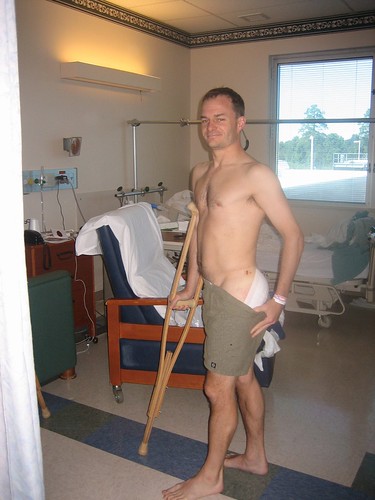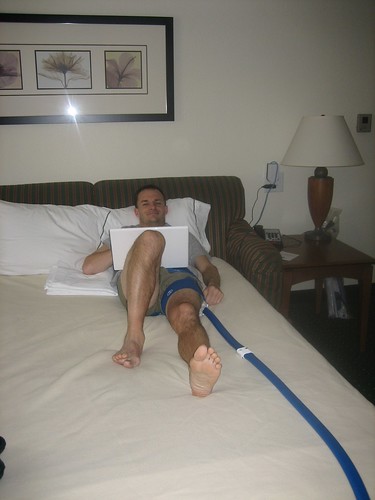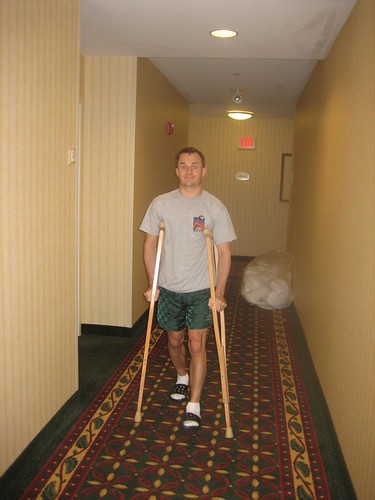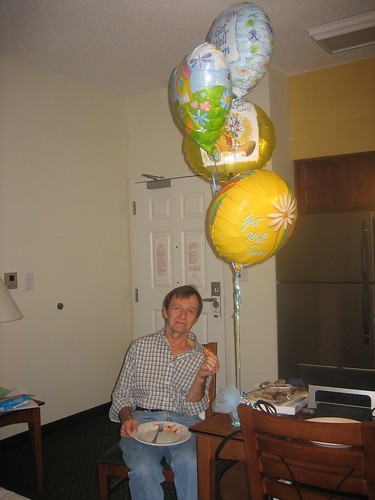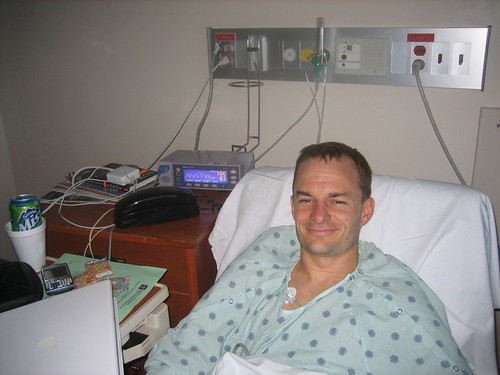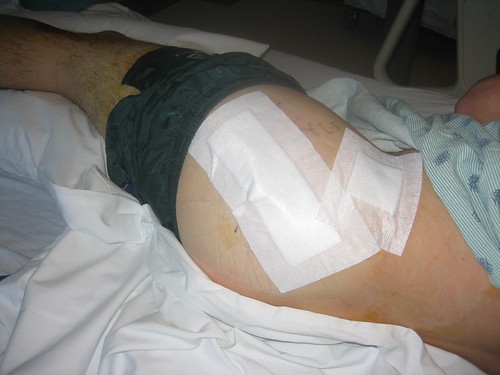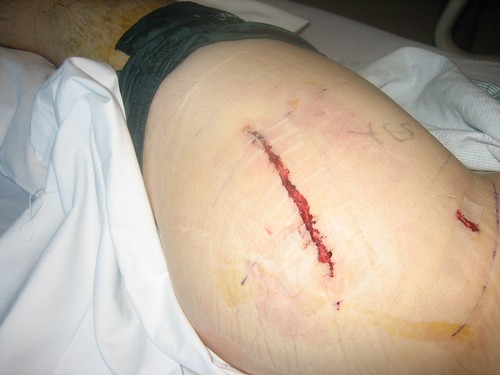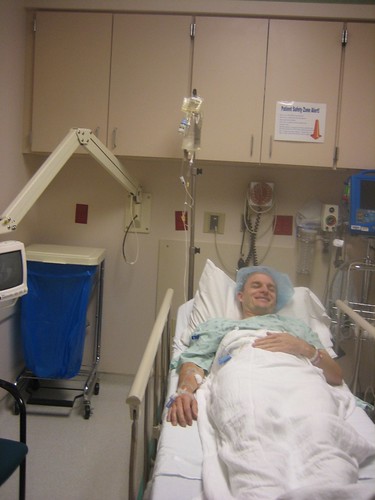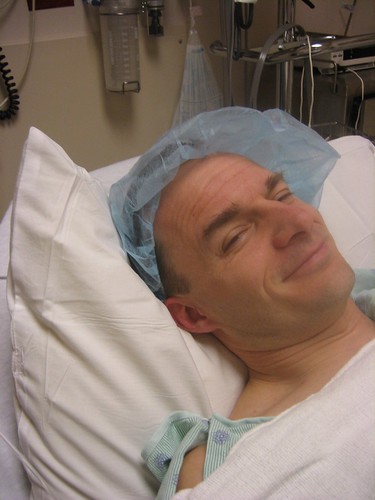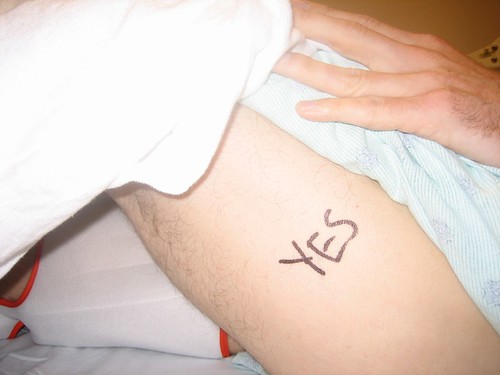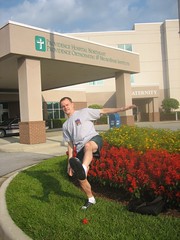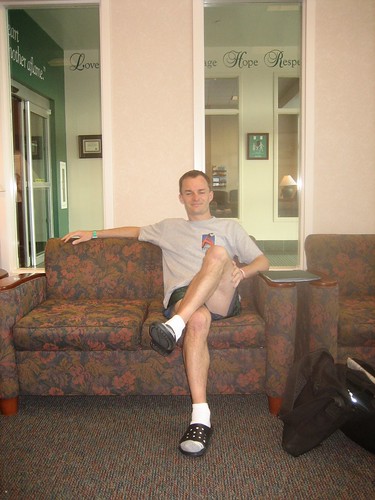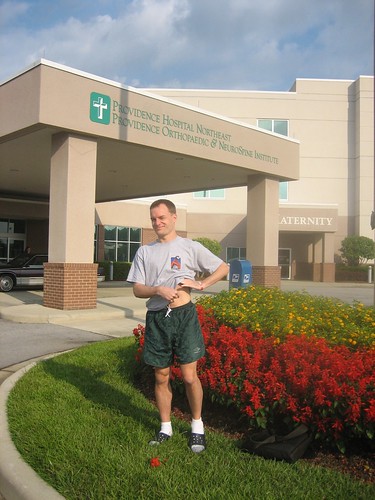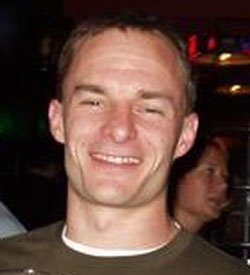I found out 4 months ago that I have osteo-arthritis in my left hip. As a thirty-seven year old recreational athlete, this came as a big shock. I’d been having hip and groin pain for 4 or 5 months but I had chalked it up to my usual pattern of playing through the pain and rushing back from injuries too soon. Sure, I was on the older side for my peer group – recreational soccer players playing 3-5 times a week – most of whom were in their mid twenties and early thirties – but arthritis was for old people. How could it happen to me? What could I do?
I’m a couple of days from surgery – a newer procedure called hip resurfacing – and I’m both excited and terrified. I thought it might help me to write about my experience before and after the procedure. Perhaps it will be useful to others, either to keep up with my progress or to help them make decisions about their own condition.
First symptomsI noticed the pain for the first time in February of this year. I was playing in an all-day soccer tournament. We did well enough in our first three games to qualify for the playoffs. This meant a fourth (and possibly a fifth) game of the day. It was midway through the third game when I began to feel a tightness in my thighs, which developed over the course of the game into a pain that made it difficult to lift my legs to run. I finished out the day but assumed I’d finally overdone it, having played a few times earlier in the week and perhaps not hydrating properly for the games. A few days later, I was back on the field and found that the pain had moved up my leg and was causing me discomfort in my groin, particularly on the left side. I decided to take it easy for a few days.
What followed over the next few weeks was a pattern of playing, taking a game off here and there, giving myself 3-4 days to feel better, followed by a return to the field and subsequent return of the pain. Sometimes I could play the game without intense pain, but I found my ability to accelerate was limited. Always, however, the next few days after playing would involve me limping around the office. I would find myself sleeping on my right side to avoid the discomfort that was growing in my left hip. Taking a week off here or there didn’t seem to help either, the pain always returned, so finally I went in to see the doctor.
Early diagnosis and TreatmentMy doctor did some flexibility and strength tests and felt it was unlikely I had a fracture… nor did the symptoms suggest a standard groin injury as the pain in the hip and lower back suggested the inflammation stemmed from my hip. The only likely explanation at this point was that I had bursitis, inflammation due to overuse. This seemed plausible. He prescribed me 6 weeks of physical therapy and also suggested an osteopathic surgeon if that didn’t work out.
Long story short, after weeks of physical therapy, it became clear that something still wasn’t right. The therapy seemed to help with flexibility and pain reduction, but after returning to the soccer field, it took about 20 minutes to find myself right back where I was before. I couldn’t sprint. I couldn’t kick. I couldn’t make sharp cuts. I was a shadow of the player I was before. It was frustrating and took the fun out of the game for me. I began to feel old. Yet, I didn’t want to believe it was over. Sports (soccer, basketball, football, snowboarding, tennis…) are such a big part of my life – I cherish the moments of glory, the pressure, the structure of it, the social aspects of being out there working towards a common goal with people I know. The sheer joy of accelerating, flying down a field or having your body do something amazing without your even planning it – these are things I miss.
"You have arthritis"The surgeon I saw was puzzled by my symptoms – thinking that there might be a fracture of some sort, she had my hip x-rayed. The results came back and were definitive. “Well, we don’t usually see this in someone your age. You have arthritis.” The cartiledge was wearing out on my right hip, but was mostly gone on the left hip. A small cyst had developed on the head of my left femur. “Basically,” she said, “you will need to get a hip replacement. My advice to you is to make this hip last as long as you can because at your age you’ll likely need to have the replacement replaced and that can be more tricky. You can continue to exercise if you want to, but the pain will become prohibitive over time. So you should start thinking about changing your lifestyle – things like swimming and bicycling are better options for you.”
I was devastated. For some, this may have seemed like sensible advice given the circumstances, but these activities seemed like small solace to me, someone who is passionate about the sports I’ve spent my life playing. These other activities are solitary and seem to me very monotonous when compared with the challenges of team sports. Some of my favorite things to do were being taken away from me. More than that, though, was the prospect for a lifetime of pain. It appeared that I would have to hold off on surgery as long as I could, until the pain was crippling and impacting my everyday activities such as walking, standing or sitting. Dosing on Ibuprofen and Glucosomine, trying to stave off the inevitable deterioration.
How could it happen?The question had to be asked. How could I have arthritis at 37? Heredity was the most likely culprit, but my family has no history of arthritis. Subsequent tests showed no signs of it in my other joints. It appeared to isolated to my hip. Searching the internet, the only explanation I could find was overuse. Something in the way my system is structured has led to the wearing away of the cartilege. Its likely I’ve done more running that any of my recent relatives, so perhaps if they had been as active, this might have happened to them as well. I discovered an
article online that described a 10X higher likelihood of arthritis in the hips in professional soccer players – with many of these players requiring hip replacements in their late 30’s and 40’s. While my level of use was certainly not as high as a professional athlete, it suggested that this particular activity might be a big contributing factor. This was different than what affected
Floyd Landis or
Bo Jackson.
What to do about itFortunately for me, I stumbled upon a newer procedure called hip resurfacing. I discovered it while researching treatment options for my condition. One of the first sources I found was a site called '
surface hippy', which was a terrific resource for understanding this procedure. The difference between this procedure and a traditional hip replacement is that it preserves most of the femur and the femur head. The benefits of this appear to be significant. First, by preserving the femur bone the total hip replacement remains an option for later. Secondly, the procedure has much lower rates of dislocation than a replacement which means it is possible to participate in more high impact sports. This procedure is not recommended for people who are older, less active or have significant deterioration to the femoral head. Watching
this video of Dr. Mont, gave me hope again (after skipping past the long intro).
Research & Picking a SurgeonI spend a fair of time reading articles and testimonials from people who had had the procedure done. The
surface hippy group on yahoo groups was especially valuable for getting my questions answered. Some people there are really generous about answering questions, in particular I appreciated the help I got from Vicky Marlow. I had a chance to meet her and another 'hippy' for lunch and discuss their experiences. They were very encouraging, having had great success with getting the surgery done in India. After getting excited about the procedure, my biggest worry was whether my femoral head would be in good enough shape to do it. Vicky encouraged me to send my x-rays to Dr. Bose (India) or Dr. DeSmet (Belgium) -- both surgeons were very gracious to review these over email and get back to me... the news was good. I was an ideal candidate.
My plan was to see if my insurance would cover the procedure here in the states, and if not, to go overseas. Unfortunately, this procedure is so new, there were no surgeons in the bay area who had much experience doing it. I wanted to get it done by someone who really knew what they were doing. Vicky had prepared an
invaluable review of the differences between the surgeons who had done this operation the most. I ended up selecting
Dr. Gross in South Carolina. His office handles the insurance paperwork. His incision length is one of the shortest available, meaning a speedier recovery time. All of the patient testimonials I read were positive for Dr. Gross as well. Once the insurance approval came through, I'd found my surgeon.
